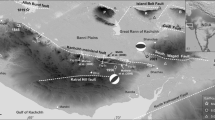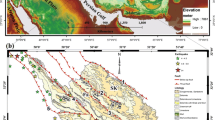Abstract
The Karakoram Highway (KKH) connects Pakistan and China by traversing through rapidly rising mountainous Karakoram area, which is the junction between the Indian and Eurasian plates including the Kohistan Island Arc. Being a plate boundary, the area is highly prone to active tectonics. The Main Mental Thrust, Main Karakorum Thrust, Main Continental Thrust and Panjal Thrust are the major fault systems operating in the region. The area is seismically active and various major earthquakes (Muzaffarabad Oct, 2005: M = 7.6, Afghanistan Oct, 2015: M = 7.5) have occurred. The geology of the area primarily consists of rocks including sedimentary, metamorphic and plutonic rocks. Granite and ultramafic rocks, slates and quartzites are the dominant lithologies of the area. Alterations of these rocks result in a large amount of incompetent and weak lithologies. The KKH passes through some of the world’s deepest gorges with high relief. The floor of these gorges is filled by glacial deposits (moraines). Since its construction in 1979, it has been damaged at various locations by a number of mass movements. In our study, data of mass movement events was acquired from Frontier Works Organisation. Then a spatial distribution map was prepared along KKH using ArcGIS. Furthermore, this mass movement distribution data was correlated with active faults, seismic information and rainfall data aiming to quantify the regression of mass movements and individual distance to active faults in the study area. Moreover, the impact of rainfalls on slope stabilities in the region is investigated. The active faults in this area have caused brittle deformation of crystalline rocks. This has resulted into poor to fair rockmass close to faults with densely populated joints having low shear strength. As a result, distances from active faults have inverse effects on mass movement events. Furthermore, rockmass quality close to the active faults is very poor having multiple joint sets. In addition, during heavy rainfall water seeps down into these joint which results in further decrease of shear strength and increase of pore water pressure, ultimately resulting in mass movements. Mass movements in Hassan Abdal-Gilgit Section showed dependence on rainfall intensity, whereas, mass movements in Gilgit-Khunjrab Pass section are function of temperature and rainfall intensity.
Access this chapter
Tax calculation will be finalised at checkout
Purchases are for personal use only
Similar content being viewed by others
References
Borneman N, Hodges KV, Wartho J (2013) The Shyok suture zone and main Karakoram thrust system in the Saltoro range of Ladakh, Northwestern India. American Geophysical Union, Fall Meeting 2013
Chen H, Dadson S, Chi Y (2006) Recent rainfall-induced landslides and debris flow in northern Taiwan. Geomorphology 77:112–125
Corominas J, Moya J (2008) A review of assessing landslide frequency for hazard zoning purposes. Eng Geol 102:193–213
Coward MP, Windley BF et al (1986) Collision tectonics in NW Himalayas. Collision Tectonics Geol Soc Lond Spec Publ 19:203–219
Dadson SJ, Hovius N, Chen H, Dade WB, Lin JC, Hsu ML, Lin CW, Horng MJ, Chen TC, Milliman J, Stark CP (2004) Earthquake-triggeredincrease in sediment delivery from an active mountain belt. Geology 32:733–736
Dai FC, Lee CF (2002) Landslide characteristics and slope instability modeling using GIS, Lantau Island, Hong Kong. Geomorphology 42:213–228
Derbyshire E, Fort M, Owen AL (2001) Geomorphological Hazards along the Karakoram Highway: Khunjerab Pass to the Gilgit River, Northernmost Pakistan. Erdkunde 55:49–71
DiPietro AJ, Hussain A, Ahmad I, Khan AM (2000) The main mantle thrust in Pakistan: its character and extent. Geol Soc Lond Spec Publ 170(1):375–393
Ercanoglu M (2005) Landslide susceptibility assessment of SE Bartin (West Black Sea region, Turkey) by artificial neural networks. Nat Hazards Earth Syst Sci 5:979–992
Gokeceoglu C, Aksoy H (1996) Landslide susceptibility mapping of the slopes in the residual soils of the Mengen region (Turkey) by deterministic stability analysis and image processing techniques. Eng Geol 44:147–161
Harp EL, Keefer DK, Sato HP, Yagi H (2011) Landslide inventories: the essential part of seismic landslide hazard analyses. Eng Geol 122:9–21
Hodges KV (2000) Tectonics of the Himalaya and southern Tibet from two perspectives. Geol Soc Am Bull 112:324–350
Hovius N, Stark PC, Allen AP (1997) Sediment flux from a mountain belt derived by landslide mapping. Geology 25:231–234
Jade S (2004) Estimates of plate velocity and crustal deformation in the Indian subcontinent using GPS. Geodesy 86(10):1443–1448
Shroder JF Jr, Bishop PM (1998) Mass movement in the Himalaya: new insights and research directions. Geomorphology 26:13–35
Keefer DK (1984) Landslides caused by earthquakes. Geol Soc Am Bull 95:406–421
Khan MA, Jan MQ (1991) An interpretation of the Himalaya-Karakoram region of Pakistan in the light of plate tectonics and rock ages. PAKISTAN J Geogr 1:114–136
Kibria S, Masud B (2011) Tackling landslides during extension of KKH, Pakistan. In: Engineering congress’s annual session proceedings, vol 70, pp 265–293
Liao Z, Hong Y, Kirschbaum D, Adler RF, Gourley JJ, Wooten R (2011) Evaluation of TRIGRS (transient rainfall infiltration and grid-based regional slope-stability analysis)’s predictive skill for hurricane-triggered landslides: a case study in Macon County North Carolina. Nat Hazards 58:325339
MonaLisa Jan M Q, Chaudhry NM (2008) Cause of right-lateral strike-slip movement in recent seismic activity in the Hazara-Kashmir Syntaxis, NW Himalaya. J Himalayan Earth Sci 41:7–18
Nagarajan R, Roy A, Kumar V, Mukherjee A, Khire MV (2000) Landslide hazard susceptibility mapping based on terrain and climatic factors for tropical monsoon regions. Bull Eng Geol Environ 58:275–287
Nandi A, Shakoor A (2010) A GIS-based landslide susceptibility evaluation using bivariate and multivariate statistical analyses. Eng Geol 110:11–20
Tahirkheli RAK, Jan MQA (1979) Preliminary geological map of Kohistan and adjoining areas, Northern Pakistan. Geol Bull Univ Peshawar 11
Ocakoglu F, Gokceoglu C, Ercanoglu M (2002) Dynamics of a complex mass movement triggered by heavy rainfall: a case study from NW Turkey. Geomorphology 42:329–341
Oguchi T, Saito K, Kadomura H, Grossman M (2001) Fluvial geomorphology and paleohydrology in Japan. Geomorphology 39:3–19
Qi SW, Xu Q, Lan HX, Zhang B, Liu JY (2010) Spatial distribution analysis of landslides triggered by 2008.5.12 Wenchuan earthquake China. Eng Geol 116:95–108
Riaz M, Khattak AG (2002) Earthquakes in Nanga Parbat Area, North Pakistan: causes and concerns with particular reference to Basha Dam. Geol Bull Univ Peshawar 35:163–173
Wang WN, Wu HL, Nakamura H, Wu SC, Ouyang S, Yu MF (2003) Mass movements caused by recent tectonic activity the 1999 Chi-Chi earthquake in Central Taiwan. Island Arc 12:325–334
Wang HB, Sassa K, Xu WY (2007) Analysis of a spatial distribution of landslides triggered by the 2004 Chuetsu earthquakes of Niigata Prefecture. Jpn Nat Hazards 41:43–60
Voelk HR (2000) Glacial and postglacial geomorphology of the middle Indus valley around Chilas, Northern Pakistan. J Nepal Geol Soc 22:405–412
Xu C, Xu XW, Yao Q, Wang YY (2013) GIS-based bivariate statistical modeling for earthquake-triggered landslides susceptibility mapping related to the 2008 Wenchuan earthquake, China. Q J Eng Geol Hydrol 46:221–236
Zhiquan Y, Yingyan Z, Shanguang Q, Kepeng H (2016) Types and space distribution characteristics of debris flow disasters along China-Pakistan Highway. EJGE 21:191–2000
Acknowledgements
We would like to thank Higher Education Commission (HEC) of Pakistan and German Academic Exchange Service (DAAD) for financial support for the research project. Further, we would like acknowledge Frontier Works Organization (FWO) and Pakistan Meteorological Department for provision of data for analysis.
Author information
Authors and Affiliations
Corresponding author
Editor information
Editors and Affiliations
Rights and permissions
Copyright information
© 2017 Springer International Publishing AG
About this paper
Cite this paper
Ali, S., Schneiderwind, S., Reicherter, K. (2017). Structural and Climatic Control of Mass Movements Along the Karakoram Highway. In: Mikoš, M., Casagli, N., Yin, Y., Sassa, K. (eds) Advancing Culture of Living with Landslides. WLF 2017. Springer, Cham. https://doi.org/10.1007/978-3-319-53485-5_60
Download citation
DOI: https://doi.org/10.1007/978-3-319-53485-5_60
Published:
Publisher Name: Springer, Cham
Print ISBN: 978-3-319-53484-8
Online ISBN: 978-3-319-53485-5
eBook Packages: Earth and Environmental ScienceEarth and Environmental Science (R0)




